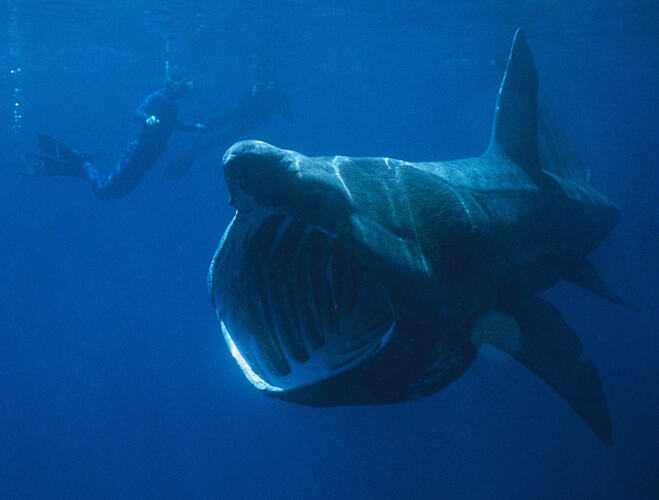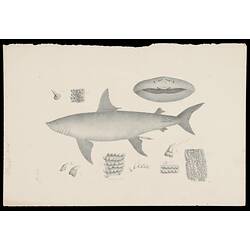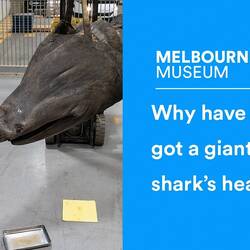General Description
Body stout, streamlined, head large, snout pointed, eye small; 5 extremely long gill slits extend from the top to the underside of the head; mouth huge, extending well beyond the eye, with rows of minute curved teeth in jaws; first dorsal, pectoral and pelvic fins large, second dorsal and anal fins small, caudal fin crescent-shaped, lower lobe somewhat smaller than upper lobe. To 12 m.
Biology
Basking Sharks are the second largest fish in the world. It is the only species in its family and is rare in Australia. While swimming, Basking Sharks feed by using thousands of bristle-like gill rakers to strain zooplankton from the water. In the Northern Hemisphere they are known to follow plankton blooms. Although they do feed in surface waters Basking Sharks also dive down to the deep waters of the "twilight" zone below 200 m and even as far as 1000 m. Here, where water temperatures are 4°C or less, they feed on tiny crustaceans and their larvae, other zooplankton and small fishes. The name Basking Shark comes from their habit of "basking" in the surface waters of the ocean. Researchers think that this "basking" behaviour may help them warm up after their deep dives into such cold water. Before they are born, Basking Shark embryos develop in the mother's uterus for between one and three years. Although female Basking Sharks produce a very large number of eggs, they give birth to relatively small litters containing up to 6 pups at a time. These pups are quite large at birth (1.5-2 m in length), so researchers think that the embryos feed on unfertilised eggs in the uterus after they use up their egg yolk. This is called "embryonic oophagy". Male Basking Sharks become mature when they are 5-7 m long, while females mature at a length between 8 and 10 m. They are usually around 12-20 years old when they reach these lengths, and the largest Basking Sharks can weigh around 7 tonnes. It is very rare to see a young basking shark less than 3 m long. Their long gestation times and slow growth make Basking Sharks vulnerable to overfishing. Historically Basking Sharks were hunted for the oil in their livers which was burned in lamps. The flesh was also eaten and the skin was tanned for use as leather. They are hunted commercially in some parts of the world but not in Australia, and their fins are prized in parts of Asia for shark-fin soup.
Distribution
Worldwide. Southern Australia along the south coast from Busselton, Western Australia to Port Stephens, New South Wales, including Bass Strait and around Tasmania.
Habitat
Cool temperate coastal seas and oceanic waters, occasionally subtropical waters.
More Information
-
Animal Type
-
Animal SubType
-
Brief Id
Large shark with a pointed snout, a large gaping mouth, five enormous gill slits around the head, mottled dark-greyish brown to almost black.
-
Colours
Grey, Brown, Grey-brown
-
Maximum Size
12.2 m
-
Habitats
-
Diet
Carnivore
-
Diet Categories
Zooplankton
-
Hazards
Not considered dangerous to humans.
-
Endemicity
-
Commercial
Yes
-
Depths
Shallow (1-30 m), Deep ( > 30 m)
-
Water Column Locations
Surface, Midwater
-
Taxon Name
-
Scientific Author
Gunnerus, 1765
-
Common Name
Basking Shark
-
Kingdom
-
Phylum
-
Subphylum
-
Superclass
-
Class
-
Subclass
-
Order
-
Family
-
Genus
-
Species Name
maximus



